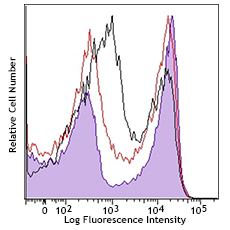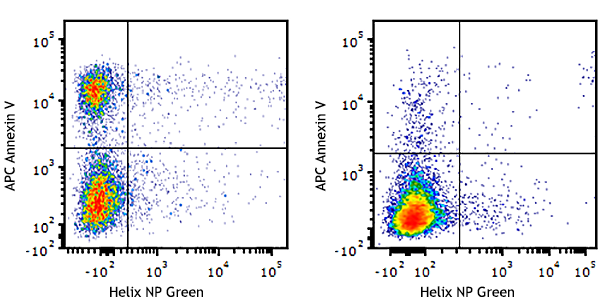- Regulatory Status
- RUO
- Other Names
- Viability dye, dead cell exclusion dye, cell viability dye
- Ave. Rating
- Submit a Review
- Product Citations
- publications
| Cat # | Size | Price | Save |
|---|---|---|---|
| 420403 | 200 tests | ¥6,600 | |
| 420404 | 500 tests | ¥12,980 |
7-AAD (7-amino-actinomycin D) has a high DNA binding constant and is efficiently excluded by intact cells. It is useful for DNA analysis and dead cell discrimination during flow cytometric analysis. When excited by 488 laser light, 7-AAD fluorescence is detected in the far red range of the spectrum (650 nm long-pass filter).
Product DetailsProduct Details
- Formulation
- PBS, pH 7.2 with 0.09% (w/v) sodium azide.
- Preparation
- CAUTION: 7-AAD is a potential carcinogen. It is recommended that the user wear protective clothing, gloves, and eye/face protection in order to avoid contact with skin and eyes.
- Concentration
- 50 µg/ml
- Storage & Handling
- Protect from light. Store between 2°C and 8°C.
- Application
-
FC - Quality tested
- Recommended Usage
-
For dead cell exclusion, resuspend cell pellet in 0.5 mL of Cell Staining Buffer and add 5 µl of 7-AAD per million cells and incubate for 5-10 minutes in the dark before analysis. The analysis of the cells should be done as soon as possible after the incubation with the dye.
We recommend utilizing our Fluorescence Spectra Analyzer to determine compatibility of 7AAD with other fluorochromes. - Excitation Laser
-
Blue Laser (488 nm)
- Application Notes
-
7-AAD Viability Staining Solution can be used as a viability probe for methods of nonviable cell exclusion.
- Additional Product Notes
-
View more applications data for this product in our Scientific Poster Library.
-
Application References
(PubMed link indicates BioLegend citation) -
- Paterson AM, et al. 2011. J. Immunol. 187:1097. PubMed
- Wingren M, et al. 2012. Arterioscler Thromb Vasc Biol. 32:2000. PubMed
- Sandu SK, et al. 2012. PNAS 109:20047. PubMed
- Evdokimova V, et al. 2012. Sci Signal. 5:92. PubMed
- Choudhury KR, et al. 2012. PLoS One. 7:e51415. PubMed
- Wu Y, et al. 2013. J. Immunol. 190:1859. PubMed
- Harker KS, et al. 2013. J. Leukoc Biol. 93:789. PubMed
- Zhang ZN, et al. 2013. Clin Chem. 59:1175. PubMed
- Mikhak Z, et al. 2013. J Exp Med. 210:1855. PubMed
- Cohen HB, et al. 2013. Blood. 122:1935. PubMed
- Hufbauer M, et al. 2013. J. Virol. 87:12158. PubMed
- Turner JE, et al. 2103. J Exp Med. PubMed
- Teng T, et al. 2013. Mol Cell Biol. 33:4660. PubMed
- Hussain MS, et al. 2013. Hum Mol Genet. 22:5199. PubMed
- Turner JE, et al. 2013 J. Exp Med. 210:2951. PubMed
- Kong W, et al. 2014. Cell Immunol. 287:1. PubMed
- Fell LH, et al. 2014. Nephrol Dial Transplant. PubMed
- Kraaji MD, et al. 2014. Cytokine. 67:7. PubMed
- Schneider C, et al. 2014. PNAS. 111:8185. PubMed
- Ermann J, et al. 2014. PNAS. 111:2559. PubMed
- Cao L, et al. 2014. J Virol. 88:8656. PubMed
- Ni PP, et al. 2014. J Immunol. 193:1778. PubMed
- Wedel J, et al. 2014. J Leukoc Biol. 96:453. PubMed
- Jaworska J, et al. 2015. J Immunol. 194:325. PubMed
- Product Citations
-
Antigen Details
- Biology Area
- Cell Biology, Cell Cycle/DNA Replication, Cell Proliferation and Viability, Neuroscience
- Antigen References
-
1. Schmid I, et al. 1992. Cytometry. 13:204
- Gene ID
- NA
- Specificity (DOES NOT SHOW ON TDS):
- 7-AAD
- Specificity Alt (DOES NOT SHOW ON TDS):
- 7-AAD
- App Abbreviation (DOES NOT SHOW ON TDS):
- FC
- Hidden Names (DOES NOT SHOW ON TDS):
- 7AAD, live dead kit
Related FAQs
- Why is washing not recommended after the addition 7-AAD or PI addition when assessing viability?
-
These dyes bind in equilibrium with DNA. Therefore, external dye concentration must be maintained during analysis and the dye should not be washed out.

















Follow Us